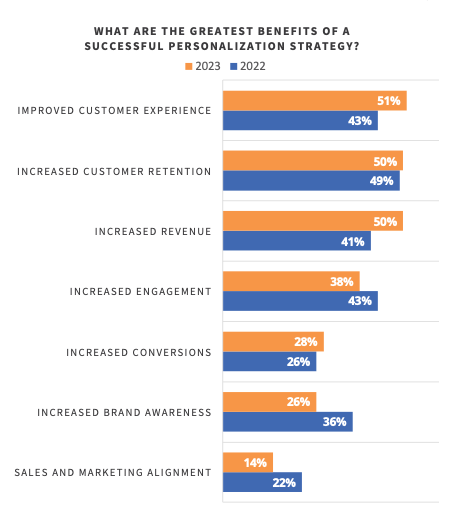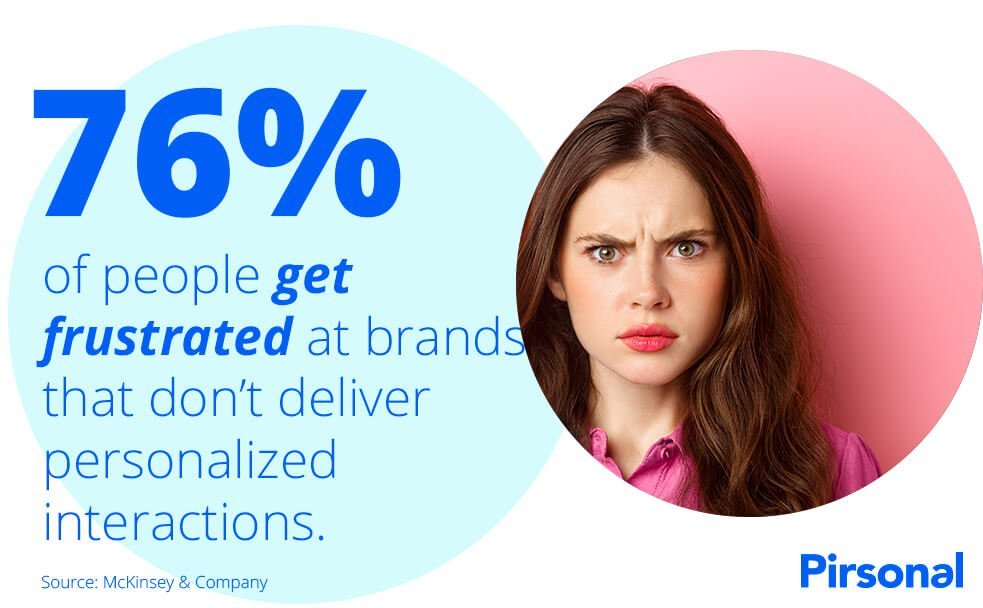People change. All the time. These changes also affect how you interact with your audiences through their life cycle.
However, there is something that doesn’t change in your customers. This is the fact that they want and demand your brand to offer an exceptional personalized experience.
This experience is delivered through a variety of touchpoints across what’s called the customer journey.
The customer journey is the path a customer takes as they interact with your business, from initial awareness to purchase and beyond.
Businesses are constantly striving to deliver exceptional customer experiences, recognizing that satisfied customers are more likely to become loyal brand advocates.
As shown in the graph below, businesses that personalize these experiences are proven to deliver an even better experience, increase retention, and boost revenue.

Comparing survey results from 2022 to 2023.
This article explains the customer journey and how you can improve customer engagement when you map it. It emphasizes the importance of understanding your audience’s needs at different stages and using personalization to increase engagement.
The Essence of the Customer Journey
The customer journey is not a linear path but rather a dynamic tapestry of touchpoints that shape a customer’s perception of your brand.
It encompasses every interaction, from online searches and social media engagement to in-store visits and customer support interactions.
By mapping the customer journey, businesses can identify key touchpoints, understand customer pain points, and find opportunities to improve the overall customer experience.
Customers progress through stages like we do in life, from birth to old age. However, their stages are not in a straight line, but can instead repeat in loops.
In marketing, we call this the customer journey. This journey has different stages your audience goes through.
These are the different stages of the customer journey:
- Awareness: This stage marks the beginning of a customer’s relationship with your brand, often triggered by a specific need or desire. They’re actively seeking information and exploring solutions, and their perception is largely shaped by external factors like advertising, social media, and word-of-mouth.
- Consideration: As the customer delves deeper into their research, they narrow down their options and begin to consider potential purchases. This is where your brand’s messaging and reputation take center stage, influencing their decision-making process.
- Decision: The customer is now ready to make a purchase, weighing the pros and cons of various options. This is where your brand’s value proposition and customer experience come into play, convincing them to choose your offering.
- Retention: Post-purchase, the customer experience continues to shape their perception. This is where loyalty programs, customer support, and after-sales service play a crucial role in retaining their satisfaction and encouraging repeat purchases.
Why Understanding the Customer Journey Matters
It may seem easy at first, but dealing with today’s well-informed and demanding customers can make it more complicated than expected.
Therefore, understanding your customers is essential.
For instance, clients who have embraced video personalization have seen the benefits of leveraging their knowledge about their customers to create personalized videos that engage with them in a more impactful way depending on their stage in the journey.
Take the following video example:
In this personalized video example, a finance mortgage company helps “Henry” understand his mortgage forbearance situation and options using the power of data-driven video and storytelling.
To achieve this, it is important to understand your audience’s context and adjust your interactions and messages accordingly.
Thus, a deep understanding of the customer journey is crucial for several reasons:
- Enhanced Customer Engagement: By understanding the customer journey, businesses can tailor their interactions to each customer’s unique needs and preferences, leading to more personalized and engaging experiences.
- Improved Customer Satisfaction: A personalized approach leads to increased customer satisfaction, as customers feel valued and understood. This, in turn, fosters loyalty and encourages repeat business.
- Increased Revenue: By identifying and addressing customer pain points, businesses can improve conversion rates and drive revenue growth.
The Role of Personas in the Customer Journey
In marketing and user experience (UX) design, a persona is a fictional representation of a typical customer or user.
Personas are created by combining demographic data, behavioral data, and psychographic data to create a comprehensive understanding of a specific customer segment.
Personas serve several important purposes in marketing and UX design:
- Understanding Customer Needs: Personas help businesses understand the needs, wants, and pain points of their customers. This understanding can be used to develop more effective marketing campaigns and create products and services that meet customer needs.
- Personalized Marketing: Personas can be used to personalize marketing messages and campaigns. By understanding what motivates each persona, businesses can tailor their messaging to resonate with specific customer segments.
- Improved User Experience: Personas can be used to improve the user experience (UX) of websites, software, and other products. By understanding how personas use products, businesses can design user interfaces that are easier to use and more intuitive.
Therefore, to understand your customers, a simple and effective approach is to ask for information. From there, try to understand that information from your customer’s perspective.
For instance, through their emotions, which are an extremely important tool to help them in their decision-making process.
Engage with customer-facing, marketing, sales, and CX teams to gather insights. Use conversations, surveys, and open-ended questions.
Additionally, I recommend talking directly to customers, leads, and prospects to learn more about their needs, requirements, concerns, interests, and questions.
By doing this, you will identify common patterns that will help you create customer personas.
Learning More About Customers
If your organization or team has the resources, you can gain even more insights from your audience.
To gain deeper insights into your customers, consider these data-driven strategies:
- Analytics: Track website traffic, social media engagement, and customer support interactions to understand customer behavior and preferences.
- Customer Feedback: Gather feedback through surveys, interviews, and social media listening to understand customer needs, pain points, and satisfaction levels.
- Customer Data Platforms: Implement a customer data platform (CDP) to centralize customer data from various sources, allowing for better personalization and segmentation.
Personalization: The Secret Ingredient for Enhanced Engagement
In this era of personalized experiences, customers expect brands to tailor their interactions to their unique needs and preferences.
Personalization goes beyond mere demographic data; it’s about understanding the customer’s context, their journey across the different stages, and their underlying motivations.
11 Reasons Why You Should Use Personalization Throughout the Customer Journey
Personalization is crucial for customer-centric businesses. It helps enhance customer engagement, drive business success, and prevent customer disengagement.
Brands that fail to personalize their interactions with customers risk losing their interest.
In fact, reports show that 76% of people get frustrated at brands that don’t deliver personalized experiences.

The majority of people dislike one-to-many marketing
Here are 11 top reasons why personalization is crucial for improving engagement throughout the customer journey:
- Builds trust and rapport: When customers feel that you understand their unique needs and preferences, they are more likely to trust your brand and develop a positive relationship with you.
- Increased customer satisfaction: Personalized interactions can help customers feel valued, appreciated, and understood. This leads to increased customer satisfaction and loyalty.
- Improved conversion rates: By tailoring your messaging and offers to individual customers, you can increase the likelihood of converting them into paying customers.
- Reduced customer churn: By providing a personalized and exceptional customer experience, you can reduce the likelihood of customers churning or switching to a competitor.
- Enhanced customer lifetime value: By building long-lasting relationships with customers through personalization, you can increase their lifetime value as a customer.
- Increased brand awareness: Personalization can help you reach a wider audience and increase brand awareness by tailoring your messaging to specific customer segments.
- Improved customer retention: Personalized interactions can help you retain customers by providing them with a seamless and consistent experience across all touchpoints.
- Boosted customer engagement: Personalized experiences can help customers engage more with your brand by providing them with relevant and timely information.
- Increased sales: Personalized marketing can help you drive sales by targeting the right customers with the right message at the right time.
- Reduced marketing costs: By personalizing your marketing campaigns, you can reduce wasted marketing spend by targeting the right customers with the right message.
- Improved competitive advantage: Personalization can help you gain a competitive advantage by providing a more personalized and engaging customer experience than your competitors.
As you can see, by understanding and tailoring experiences to individual customer needs, preferences, and behaviors, you can create a more meaningful connection with your customers, fostering loyalty, and driving long-term value.
Leveraging Personalization to Engage Customers
Personalization can be applied at every touchpoint along the customer journey, enhancing engagement and driving positive outcomes:
- Content Personalization: Craft personalized content based on a customer’s interests, purchase history, objections and online behavior. This could involve recommending specific products, providing targeted offers, and helping your audience understand their current and future state through their data.
- Contextual Personalization: Understand the customer’s context, such as their location, time of day, or device, and tailor the experience accordingly. For instance, offering relevant discounts or promotions based on their current location or time zone.
- Predictive Personalization: Utilize machine learning and predictive analytics to forecast customer behavior and anticipate their needs. This enables proactive engagement, such as sending reminders about abandoned carts or recommending complementary products.
- Omnichannel Personalization: Create a seamless and consistent experience across all touchpoints, from website interactions to social media engagement and customer service interactions. This reinforces brand identity and builds trust.
Aligning Personalization with Business Goals
While personalization is a powerful tool for enhancing engagement, it’s essential to align it with your business goals.
Identify the key metrics that matter to you, such as conversion rates, customer satisfaction, and brand loyalty.
Then, use personalization strategies to drive those metrics and achieve your business objectives.
A Customer Journey Example in the Financial Services Industry
Let’s consider a customer journey in the financial services industry, specifically the process of opening a new bank account.
Persona:
- Name: Alex
- Gender: Femail
- Age: 35
- Occupation: Accountant
- Location: Suburban neighborhood
- Financial Goals: Save for retirement, manage monthly expenses, and secure a mortgage
Customer Journey Stages:
- Awareness: Alex begins researching online about different bank options, comparing interest rates, fees, and customer reviews.
- Consideration: Alex narrows down her choices and visits the websites of the shortlisted banks, comparing their online banking platforms and customer support services.
- Decision: Alex decides to open an account with a bank that offers competitive interest rates, retirement savings financial products, a user-friendly online banking platform, and a branch conveniently located near her home.
- Retention: Alex establishes a positive relationship with the bank and offers the personalized experiences she values, utilizes its various services, and receives timely and helpful customer support when needed.
Personalization Strategies:
There are many ways to engage with your audience across the customer journey. One of our favorite ones at Pirsonal because its effectiveness is through personalized interactions.
Back to Alex’s example, let’s say your organization has found that customers, like Alex, have difficulty understanding complex retirement savings terms and how to make the most of your service to save more money for the future.
Personalization, then, can address this by tailoring it to her specific situation. One effective method is using personalized video storytelling.
Here’s an example:
As you can see, personalized videos are a potent way to lean on your customer’s emotions to connect with customers. They are also more effective than one-fits-all videos.
Therefore, the most effective approaches throughout the customer journey include:
- Targeted Marketing: Send personalized email offers based on Alex’s financial goals and interests.
- Contextual Personalization: Create personalized videos that help Alex understand her progress according to her saving goals for her retirement. Offer tailored product recommendations based on her account activity and transaction history.
- Omnichannel Personalization: Provide seamless and consistent experiences across all touchpoints, from mobile apps to online banking and branch interactions.
Mapping Your Customer Journey And Using Personalization
Now it’s your turn. To effectively map your customer journey, follow these steps:
- Identify Key Touchpoints: List all the interactions a customer has with your brand, from website visits to phone calls and social media engagement.
- Understand Customer Pain Points: Gather feedback from customers through surveys, interviews, and social media listening to identify common pain points and areas for improvement.
- Map Touchpoints to Customer Stages: Categorize your touchpoints based on the different stages of the customer journey, such as awareness, consideration, decision, and retention.
- Analyze Customer Behavior: Utilize analytics to track customer behavior across different touchpoints and identify trends and patterns.
- Identify Opportunities for Personalization: Analyze customer data and behavior to identify opportunities to personalize interactions and enhance the experience.
Watch the video shared above to understand these concepts.
Now, check out the PDF for a simple method to map your customer’s journey. It correlates the type of content that resonates with them and emphasizes personalized videos as an effective way to increase engagement.
Conclusion: Personalization as the Cornerstone of Engagement
In conclusion, understanding the customer journey and leveraging personalization are not just buzzwords but essential strategies for businesses seeking to thrive in today’s competitive landscape.
By tailoring each interaction to the customer’s unique context and preferences, you can create a personalized experience that resonates deeply, fosters loyalty, and drives sustainable growth.
Remember, personalization is not about bombarding customers with targeted ads; it’s about understanding their needs and providing meaningful value that enhances their journey.
Boost Engagement Throughout the Customer Journey With Personalized Videos and Pirsonal
Use personalized videos to improve customer engagement; get hands-on help from Pirsonal. We help you understand how personalized videos can help your team connect with your audience, step by step, even if you are not an expert.
Contact us today to understand how personalized videos can help you connect with your audience so that they pay attention, engage, and act.

